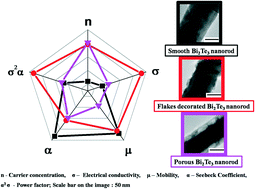Morphological investigations on the growth of defect-rich Bi2Te3 nanorods and their thermoelectric properties†
Abstract
Bi2Te3 nanorods (NRs) have been successfully synthesized at different reaction temperatures via a surfactant-assisted hydrothermal method. The experimental observations revealed that the reaction temperature, SDBS surfactant (sodium dodecylbenzene sulphonate) and its concentration affect the morphology of Bi2Te3. It is identified that an imperfect oriented attachment mechanism is the dominant growth mechanism for the evolution of Bi2Te3 NRs. Moreover, a subsidiary growth mechanism namely the Oswald ripening process could also affect the Bi2Te3 NR growth process at higher reaction temperatures. Thermoelectric property measurements revealed that flake-decorated Bi2Te3 NRs achieved the maximum power factor value of ∼1.32 μW cm−1 K−2 at 410 K, which was higher than those of porous and smooth Bi2Te3 NRs. Such an enhancement in the power factor of flake-decorated Bi2Te3 NRs is primarily attributed to their outstanding electrical conductivity at 410 K.



 Please wait while we load your content...
Please wait while we load your content...